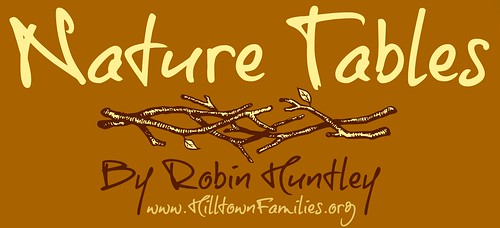Nature Table for September
A Transition Between Seasons Brings a Colorful Table

Every month, Hilltown Families features a new nature table whose contents inspire learning along a common theme easily spotted in our surroundings that month. A tradition carried out by teachers, environmental educators, and nature-curious families, nature tables bring a little bit of the outdoors inside for inspection, dissection, identification, creative play, art projects, and lots of other educational activities. The idea behind a nature table is to help open up children’s eyes to the unique attributes of each season, and to help them learn how to see these things in nature for themselves. A nature table can include a variety of items, and is often accompanied by a set of books and/or field guides so that children can take part in further learning at their own will.
September has brought a nature table filled by the hands of young amateur scientists. As we work to build our new classroom community together, we’re also learning how to look at the world around us. Writing lessons take us outside with clipboards, ready to write about the things that we find. Science sends us on a hunt for specific items, though we’re easily side-tracked by crickets and butterflies. Math surveys are centered around favorite local animals, and whether or not we go hunting with our families. Outside games disintegrate into a group effort to free apples from trees using sticks…
Lucky for all of us, fall’s graceful appearance comes on slow, allowing us to soak it in. Our collecting so far has been filled with excitement over the very, very first signs that the seasons are beginning to change. Sumac – plentiful ’round these West County parts – has started to turn a little bit, and golden rod is blooming with glory. Both of these have been major players in our early fall table-scape, reminding us of the overlap of summer and fall. The half-eaten apples we’ve found (and have watched quickly brown) can only be the leftovers of a feasting animal, though the students don’t seem to be inclined to believe its origins.
One surprise addition to our September collection of nature treasures was a pretty major colony of aphids. A beautiful bloom of gladiola that welcomed students into the classroom two weeks ago wilted slowly before our eyes (quite the dramatic process of dying) and turned out to look “fuzzy” – the fuzz look being the result of a thin coating of aphids, happily enjoying life inside out classroom. Some of the little green guys are in a jar and have been under close observation, but most of them will need to adjust to the mossy ground just outside the classroom door.

This month’s collection includes:
- crispy sumac and maple leaves
- tiny crab apples
- snakeskin
- iris seed pods
- feathers
- walnuts (including an inside view)
- goldenrod (dead and alive)
- apples and apple leaves
- aphids
We’ve been learning more about our treasures using:
- Botany (Ladybird Science) by John and Dorothy Paull
- The Secret Forests: Hide-and-Seek Creepy Crawly Book by Michael Gaffney
- Tree (Eyewitness Books)
- Mountain Flowers in Color by Anthony Huxley
- My Side of the Mountain by Jean Craighead George
- Outside and Inside Snakes by Sandra Markle
Robin Morgan Huntley, Community-Based Education Correspondent
 A native to Maine, Robin joined Hilltown Families in early 2011. She is a graduate of Antioch University with a masters in education. Her interests within the field of education include policy and all types of nontraditional education. For her undergraduate project at Hampshire College, Robin researched the importance of connecting public schools with their surrounding communities, especially in rural areas. Robin lives and teaches 5th grade in the Hilltowns of Western MA. importance of connecting public schools with their surrounding communities, especially in rural areas. Robin lives in Shelburne Falls, MA.
A native to Maine, Robin joined Hilltown Families in early 2011. She is a graduate of Antioch University with a masters in education. Her interests within the field of education include policy and all types of nontraditional education. For her undergraduate project at Hampshire College, Robin researched the importance of connecting public schools with their surrounding communities, especially in rural areas. Robin lives and teaches 5th grade in the Hilltowns of Western MA. importance of connecting public schools with their surrounding communities, especially in rural areas. Robin lives in Shelburne Falls, MA.
 Hilltown Families
Hilltown Families 




























